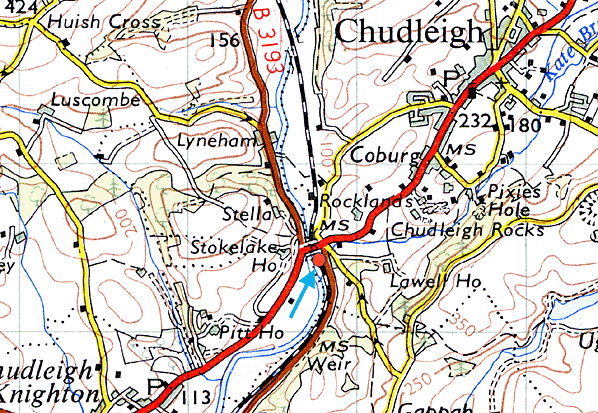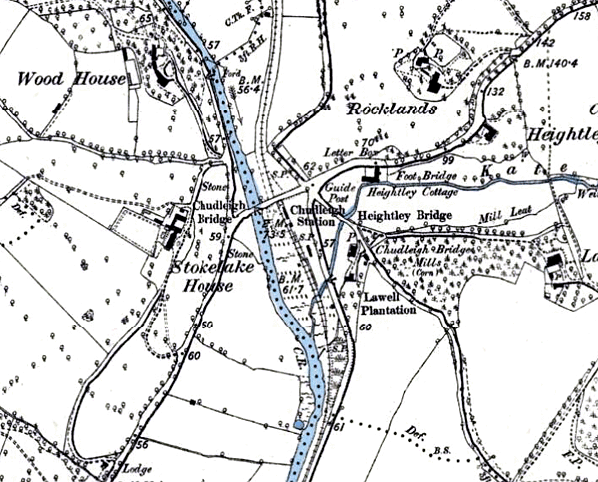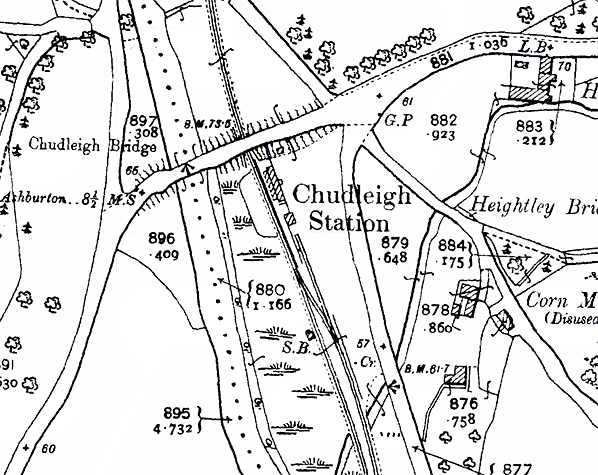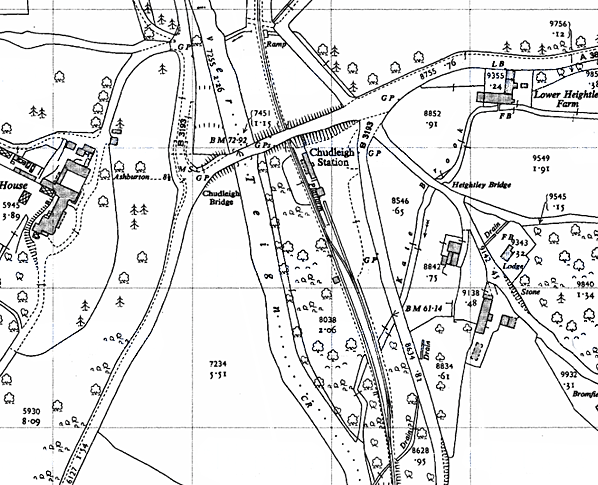|
Notes: At Chudleigh, the original proposal in the early 1860s was for the railway to cross the turnpike road on the level with a crossing adjacent to where the overbridge was eventually built. This was rejected by Parliament, and various alternative routes were then considered; this became known as the 'Chudleigh Deviation'. Routes either side were also rejected due to objections from landowners and the matter was left in abeyance until 1868 when a compromise was found that would satisfy all parties. The solution was an overbridge; initially this would have involved raising the approaches by 17ft but this was not acceptable and eventually, in 1872, Parliament finally agreed to an overbridge with the stipulation that the approaches must not be raised more than 7ft.
After nine years of stalemate work was underway, but this 'final solution' would, in time, prove wholly unsatisfactory, as in order to leave sufficient clearance for trains passing under the bridge the track had to be lowered taking it below the level of the floodplain. As a result, the station flooded almost every winter as the water level rose in the adjacent River Teign. This regular occurrence became so acute in the mid 1920s that a raised gangway from an adjacent lane was built leading to a special timber platform constructed on the north side of the A38 for use on such occasions. Passengers from Exeter would alight at this platform from where they would be taken to Heathfield by bus to continue their journey to Newton Abbott.
 It was still a further five years before work began at Chudleigh. Construction of the station and the laying of the track started in 1877 and work on the overbridge started the following year. The goods dock was completed in 1879 and the steps down the embankment from the road and the parcels store were completed in 1881. The following year, the sidings were laid and the signal box was completed. After five years under construction the station finally opened on 9 October 1882. At this time the line ran only as far as Ashton, a distance of 6¼ miles from Heathfield. Chudleigh was the first intermediate station at a distance of two miles from Heathfield. It was still a further five years before work began at Chudleigh. Construction of the station and the laying of the track started in 1877 and work on the overbridge started the following year. The goods dock was completed in 1879 and the steps down the embankment from the road and the parcels store were completed in 1881. The following year, the sidings were laid and the signal box was completed. After five years under construction the station finally opened on 9 October 1882. At this time the line ran only as far as Ashton, a distance of 6¼ miles from Heathfield. Chudleigh was the first intermediate station at a distance of two miles from Heathfield.
Chudleigh station was a mile south of the town with a large forecourt alongside the B3193 leading to Kingsteignton. It had a single platform 160ft in length on the east side of the line, faced in granite and edged with concrete slabs. The main station building was of timber below a pitched grey slate roof and almost identical to that at Heathfield; it had a canopy with a deep valance stretching part way across the platform and a wing at either end and a small entrance porch. It was faced with horizontal weatherboarding painted sand and buff. The two end-wings contained the gents' toilet and a store/parcel room.
A few yards to the south along the platform, there was a timber parcels lockup. This had a sliding door on the platform and another door with a porch at the rear to transfer goods to and from road vehicles. There was a station nameboard sandwiched between the station building and the lock-up. Chudleigh was the only station on the Teign Valley line to operate a parcel collection and delivery service in the town.
The small goods yard comprised a long loop to the south of the station on the east side from which a short siding ran into a 100ft-long dock behind the platform. The station did not handle livestock apart from horse boxes, and the siding usually contained coal wagons. There was a 3-ton capacity crane. Access to the yard was controlled by the timber-clad signal box with a 13-lever frame opposite the north end of the loop on the west side of the line. The box closed in 1910 and was replaced with two 2-lever ground frames. In 1940 the top part of the box was removed and the bottom part was roofed over and used as a permanent way mess hut.
The people of Chudleigh had waited a long time for their station and it was immediately well used with almost 1,000 tickets being sold during the first week. Passenger receipts continued to rise each year reaching a peak in 1913 when 19,895 tickets were sold. 1913 was also the peak for goods traffic with 11,488 tons handled, 95% being inward traffic.
Following WW1, when the railways were taken into Government control, passenger numbers began to decline following the new Devon General motor-bus service that had been introduced between Exeter and Newton Abbot via Chudleigh.
The initial train service to Ashton consisted of five in each direction. When the line was finally extended to Exeter on 1 July 1903, six trains operated in each direction. In 1924 this was increased to seven but in 1939 it was reduced to four as a wartime economy measure. By 1943 freight tonnage had halved from its 1913 high with 6,120 tons being handled. In 1946 the passenger service was increased to five and remained at this number until closure of the line. A camping coach was introduced in 1939 but was removed during the war; returning between 1956 and 1958.

After the passenger service was withdrawn in 1958 the station building was boarded up and the canopy was removed. One man was retained to supervise freight and parcel traffic. The general freight service was withdrawn on 14 June 1965; after this date the station was classed as a coal depot with coal and oil for the gasworks at Oldway being unloaded there until 4 December 1967.
The station was demolished in early 1970 during the construction of the Chudleigh bypass which opened on 21 June 1973. The B3334 was widened at this time, and it had a junction with the new bypass immediately east of the station site. The original bridge over the railway was retained, now sandwiched in the middle of a much wider bridge over the trackbed. The station site also still exists. The trackbed can be followed north from Chudleigh Knighton to Chudleigh station although it is not an official footpath. The station site has now been bisected by a widened Kate Brook, a small tributary of the River Teign. Its confluence with the river was moved north close to the overbridge during the construction of the bypass.
Fore more information about the Teign Valley Railway and Chudleigh Station see Chudleigh History Group web site
BRIEF HISTORY OF THE TEIGN VALLEY RAILWAY
The Teign Valley Line was originally authorised in 1863 as a broad gauge line, although it did not open until 1882. The line ran as standard gauge from Heathfield to Ashton, although it was isolated from the GWR system as the Moretonhampstead line at Heathfield was still broad gauge.
 Some forty years later, the Exeter, Teign Valley and Chagford railway was formed to build a line from Exeter to join up with the existing line connecting at Christow station. This opened on 1st July 1903 some 9 years after the first sod had been cut by Lady Northcote, wife of the Member of Parliament for Exeter on 7th November 1894. The 1st official train left St Thomas station (Exeter) at 3.40pm and arrived at Ide at 4pm calling at all the stations on the line where each parish council laid on festivities and the usual address by councilors. Some forty years later, the Exeter, Teign Valley and Chagford railway was formed to build a line from Exeter to join up with the existing line connecting at Christow station. This opened on 1st July 1903 some 9 years after the first sod had been cut by Lady Northcote, wife of the Member of Parliament for Exeter on 7th November 1894. The 1st official train left St Thomas station (Exeter) at 3.40pm and arrived at Ide at 4pm calling at all the stations on the line where each parish council laid on festivities and the usual address by councilors.
The line which extends from Heathfield on the Newton Abbot to Moretonhampstead line in the south to Exeter on the main London to Cornwall line covers a total of 17 miles. It consists of approximately 25 bridges, 30 culverts and 2 tunnels, one each side of Longdown station. These tunnels were built to hide the offensive sight of the trains from Edward Byrom of Culver House which stands in parkland above the railway.
The largest customer for goods traffic on the line was the Teign Valley Granite Company which had quarries at Trusham and Crockham. Not only was the line used for local connections but it also provided an alternative route to Cornwall, bypassing the troublesome route from Exeter to Newton Abbot which regularly (and still does) suffered from the elements from the sea around Dawlish

Prior to the opening of the through line in 1903, passenger services on the original line consisted of 5 trains daily in each direction on weekdays only, with no trains at all on Sundays. When the line opened from Exeter the passenger service was integrated with that of the Teign Valley Railway. The Exeter Railway and the Teign Valley Railway were both absorbed into the Great Western Railway in 1923.
Passenger numbers reached their peak in the 1930’s with seven daily services provided each way between Exeter and Heathfield. During World War 2 this was reduced to four trains in each direction, still with no trains on a Sunday. This was increased to five daily trains after the war.
By then it was becoming obvious that the branch was going into decline as more people took to the motor car as their main form of transport, a trend that was happening nationally. As a result BR decided to withdraw passenger services a full 5 years before the start of the ‘Beeching Axe’, even though Ashton station had only been repainted the year before closure.
 In 1957 The British Transport Commission proposed to withdraw the passenger train service between Exeter (St David’s) and Heathfield and to close down Longdown station. It was followed in early 1958 by a further notice saying that as from 3rd March 1958 that the passenger train service between Exeter (St David’s) and Heathfield stations would be permanently withdrawn and Longdown, Alphington, Ide, Dunsford and Chudleigh Knighton would be closed for passengers and goods. The parcel service would still continue for the delivery and collection of parcels at Chudleigh, Trusham, Ashton and Christow stations. The line was granted a short reprieve by a protest by St Thomas Rural District Council (Exeter) because of the inadequate bus service, this reprieve was short lived as on 9th June 1958 the passenger service was finally withdrawn and the section of line from Exeter to Christow closed completely. In 1957 The British Transport Commission proposed to withdraw the passenger train service between Exeter (St David’s) and Heathfield and to close down Longdown station. It was followed in early 1958 by a further notice saying that as from 3rd March 1958 that the passenger train service between Exeter (St David’s) and Heathfield stations would be permanently withdrawn and Longdown, Alphington, Ide, Dunsford and Chudleigh Knighton would be closed for passengers and goods. The parcel service would still continue for the delivery and collection of parcels at Chudleigh, Trusham, Ashton and Christow stations. The line was granted a short reprieve by a protest by St Thomas Rural District Council (Exeter) because of the inadequate bus service, this reprieve was short lived as on 9th June 1958 the passenger service was finally withdrawn and the section of line from Exeter to Christow closed completely.
The track on this section was lifted in February 1962 except for the short length from Exeter to Alphington Road sidings (Marsh Barton Industrial estate). This part of the line still survives today, serving a scrap metal company and this is still used regularly (2010), beyond here towards Heathfield the line has been severed by a supermarket.
BR's reasoning behind the closure was the line was only used for an average of 193 daily journeys and closure would give them a saving of £15,000 per annum with a further saving of £30,000 that would be required for general up-keep of the line.
March 1961 saw flooding which damaged the line between Christow and Ashton resulting in the closure of the line east of Trusham. BR officially closed the section of line between Heathfield and Crockham sidings (just south of Trusham) on 1st July 1968.
Further reading: The Heathfield to Exeter (Teign Valley) Railway by Lawrence Pomroy - Forest Publishing 1995 ISBN 1 873029 04 7
Teign Valley Line by Peter Kay - Wild Swan 1996 ISBN 1 874103283
Branch Line to Moretonhampstead (including Heathfield - Exeter) by Vic Mitchell & Keith Smith
Middleton Press 1998 ISBN 1 901706 273
Walking West Country Railways by Christopher Somerville - David & Charles 1979
ISBN 0 715381421
Devon's Railways by Helen Harris - Bossinney Books 2001 ISBN 899383 40 9
Branch Lines of Devon by Colin Maggs
- Sutton Publishing 1995 ISBN 1 84015 022x
To see other Stations on the Teign Valley Railway click on the station name: Heathfield, Chudleigh Knighton Halt, Trusham, Ashton, Christow, Dunsford Halt, Longdown, Ide Halt & Alphington Halt
|

old3.jpg)




old7.jpg)
old4.jpg)
old2.jpg)
old8.jpg)
old5.jpg)
old6.jpg)
old9.jpg)
old8.jpg)
 Home Page
Home Page  It was still a further five years before work began at Chudleigh. Construction of the station and the laying of the track started in 1877 and work on the overbridge started the following year. The goods dock was completed in 1879 and the steps down the embankment from the road and the parcels store were completed in 1881. The following year, the sidings were laid and the signal box was completed. After five years under construction the station finally opened on 9 October 1882. At this time the line ran only as far as Ashton, a distance of 6¼ miles from Heathfield. Chudleigh was the first intermediate station at a distance of two miles from Heathfield.
It was still a further five years before work began at Chudleigh. Construction of the station and the laying of the track started in 1877 and work on the overbridge started the following year. The goods dock was completed in 1879 and the steps down the embankment from the road and the parcels store were completed in 1881. The following year, the sidings were laid and the signal box was completed. After five years under construction the station finally opened on 9 October 1882. At this time the line ran only as far as Ashton, a distance of 6¼ miles from Heathfield. Chudleigh was the first intermediate station at a distance of two miles from Heathfield. 
 Some forty years later, the Exeter, Teign Valley and Chagford railway was formed to build a line from Exeter to join up with the existing line connecting at Christow station. This opened on 1st July 1903 some 9 years after the first sod had been cut by Lady Northcote, wife of the Member of Parliament for Exeter on 7th November 1894. The 1st official train left St Thomas station (Exeter) at 3.40pm and arrived at Ide at 4pm calling at all the stations on the line where each parish council laid on festivities and the usual address by councilors.
Some forty years later, the Exeter, Teign Valley and Chagford railway was formed to build a line from Exeter to join up with the existing line connecting at Christow station. This opened on 1st July 1903 some 9 years after the first sod had been cut by Lady Northcote, wife of the Member of Parliament for Exeter on 7th November 1894. The 1st official train left St Thomas station (Exeter) at 3.40pm and arrived at Ide at 4pm calling at all the stations on the line where each parish council laid on festivities and the usual address by councilors.
 In 1957 The British Transport Commission proposed to withdraw the passenger train service between Exeter (St David’s) and Heathfield and to close down Longdown station. It was followed in early 1958 by a further notice saying that as from 3rd March 1958 that the passenger train service between Exeter (St David’s) and Heathfield stations would be permanently withdrawn and Longdown, Alphington, Ide, Dunsford and Chudleigh Knighton would be closed for passengers and goods. The parcel service would still continue for the delivery and collection of parcels at Chudleigh, Trusham, Ashton and Christow stations. The line was granted a short reprieve by a protest by St Thomas Rural District Council (Exeter) because of the inadequate bus service, this reprieve was short lived as on 9th June 1958 the passenger service was finally withdrawn and the section of line from Exeter to Christow closed completely.
In 1957 The British Transport Commission proposed to withdraw the passenger train service between Exeter (St David’s) and Heathfield and to close down Longdown station. It was followed in early 1958 by a further notice saying that as from 3rd March 1958 that the passenger train service between Exeter (St David’s) and Heathfield stations would be permanently withdrawn and Longdown, Alphington, Ide, Dunsford and Chudleigh Knighton would be closed for passengers and goods. The parcel service would still continue for the delivery and collection of parcels at Chudleigh, Trusham, Ashton and Christow stations. The line was granted a short reprieve by a protest by St Thomas Rural District Council (Exeter) because of the inadequate bus service, this reprieve was short lived as on 9th June 1958 the passenger service was finally withdrawn and the section of line from Exeter to Christow closed completely. 